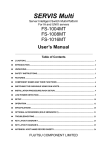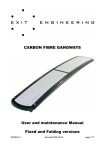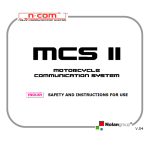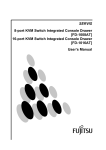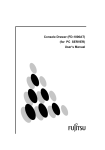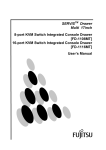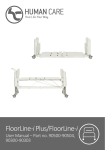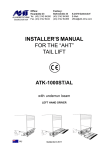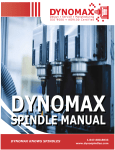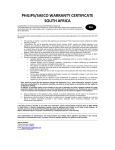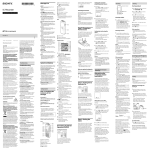Download User Manual
Transcript
Console Drawer (FD-1000ST) (for SUN / PC SERVER) User’s Manual This device has been classified as a Class A product by VCCI (Voluntary Control Council for Interference by Information Technology Equipment). If you use this product in a domestic environment, it may cause radio interference, in which case the user may be held responsible for the cost of any required corrective action. This Product is designed, developed and manufactured as contemplated for general use, including without limitation, general office use, personal use, household use, and ordinary industrial use, but is not designed, developed and manufactured as contemplated for use accompanying fatal risks or dangers that, unless extremely high safety is secured, could lead directly to death, personal injury, severe physical damage or other loss (hereinafter "High Safety Required Use"), including without limitation, reaction core control in nuclear power facilities, aircraft autopilot flight control, air traffic control, operation control in mass transport control systems, medical instruments for life support systems, missile launching control in weapon systems. You shall not use this Product without securing the sufficient safety required for the High Safety Required Use. If you wish to use this Product for High Safety Required Use, please consult with our sales representatives in charge before such use. Names and product names are the registered trademarks or trademarks of their respective companies. All Rights Reserved, Copyright© FUJITSU COMPONENT LIMITED 2003 Contents PREFACE .....................................................................................................................1 Conventions .............................................................................................................1 Packing List ..............................................................................................................1 IMPORTANT NOTICES ................................................................................................3 Safety .......................................................................................................................3 Precautions..........................................................................................................3 Disposal...............................................................................................................4 Moving Console Drawer ...........................................................................................4 INSTALLATION ............................................................................................................5 Installing Guide Rails................................................................................................5 Installing Console Drawer ........................................................................................7 Installing the 4-port KVM Switch (CRT/KB Switcher) ...............................................8 CONNECTING AND REMOVING CABLES ...............................................................12 Connecting Cables .................................................................................................12 Removing Cables ...................................................................................................12 Connecting to Ports ................................................................................................13 OPERATION ...............................................................................................................14 Operating the Console Drawer ...............................................................................14 Adjusting the Monitor..............................................................................................17 Basic Adjustment Procedure .............................................................................18 Menu Screen Display Example .........................................................................18 Menu Description...............................................................................................19 Resolution and Refresh Rate ............................................................................20 Keyboard Operation ...............................................................................................20 Pointing Device Operation......................................................................................21 Hot-key and Reset Buttons ....................................................................................22 Using CRT/KB Switcher .........................................................................................23 Storing Console Drawer .........................................................................................24 Cleaning Console Drawer ......................................................................................26 TECHNICAL SPECIFICATIONS ................................................................................27 i ii Preface Congratulations on your purchase of the server rack mountable Console Drawer. Using this product will greatly improve the efficiency and functionality of the workspace around your racks. Space that was used in previous layouts can now be used more freely due to our compact sliding module design. The 15-inch TFT monitor has a resolution of 1024 to 768 dots with 16,770,000 colors. Also, it is equipped with a keyboard and 3-button pointing device. Conventions Symbols and terminology that are used in this manual are described below. CAUTION This symbol indicates the possibility of physical damage (such as damage to the Console Drawer) or physical injury, which may result if the Console Drawer is operated incorrectly by ignoring this symbol. This logo indicates supplemental information, comments or hints. ● ● Text that is preceded by a number (such as 1.) indicates that the operation must be done in the order indicated. Reference to important chapter titles and terminology are in brackets [ ]. Packing List Make sure that the items in the following list were included in the shipping package. ● ● ● ● Console Drawer 1 ea. Power Cable (2 m) 1 ea. Operation Manual (this manual) 1 ea. Warranty 1 ea. (included in NC14003-T561 and NC14003-T562 only) (Make sure that the warranty includes all the required information.) We recommend keeping the box and packing material in which the Console Drawer was purchased. They may be required when moving it to another location. If something is missing from the package, contact your place of purchase or a Fujitsu maintenance person. 1 CAUTION Please note the safety information in [Important Notices]. 1. Check the package delivered and whether the Console Drawer has been damaged when unpacking. 2. Remove the rubber stabilizer from the front left side of the Console Drawer. The rubber stabilizer is inserted to prevent the Console Drawer from sliding when installing or moving it. Be sure to keep it after finishing the installation for when it needs to be used again. Rubber stabilizer removal 2 Important Notices This chapter contains cautions that must be taken when operating the Console Drawer and information related to safety. Carefully read this chapter to use the Console Drawer correctly. Safety CAUTION Precautions This device adheres to the safety regulations related to information processing equipment such as electronic office machines that are used in an office environment. If you have any questions please contact your place of purchase or a Fujitsu maintenance person. ● ● ● ● ● ● ● ● ● ● ● ● ● To prevent extreme bumping or shaking when moving the Console Drawer use the original shipping container or a box similar to it. During installation and before using the Console Drawer, carefully read [Installation] and the section about environmental conditions in [Technical Specifications] to use the Console Drawer correctly. Moving the Console Drawer from a cold environment to the installation location may cause condensation to occur. Before using the Console Drawer allow it to dry out completely and to reach the ambient temperature of the installation location. Make sure that the local power supply voltage is within the acceptable range of the Console Drawer. Make sure that the rated voltage meets the specifications of this device (Refer to [Technical Specifications] and the model plate on this device). The power cable for the Console Drawer is specially certified. Do not connect it to anyplace other than a grounded wall outlet in order to avoid electric shocks and/or short circuit. Arrange the immediate area around the Console Drawer's power socket and the rack's power outlet so that the plug can be quickly pulled. Lay all the cables so that they will not be damaged. Refer to the relevant sections in [Installation] when connecting and removing cables. Do not connect or remove the data transmission cables during thunderstorms. Do not allow foreign substances (such as necklaces or paperclips) or liquids inside the Console Drawer. In an emergency (such as: damage to the housing, parts or cables; or liquid or a foreign object has fallen into the Console Drawer) remove the power cable as soon as possible and contact your place of purchase or a Fujitsu maintenance person. Only licensed engineers can repair the Console Drawer. An unlicensed user that opens the Console Drawer and makes incorrect repairs may cause electric shock or fire. Avoid using the keyboard when in poor health or for extended periods of time. Always hold the connector portion and do not jerk the cables when removing them. 3 ● ● ● ● ● ● ● ● ● ● ● Avoid operating the Console Drawer with wet hands. Do not plug or unplug connectors with wet hands. Do not place such unnecessary items as cups on the top of the Console Drawer. Do not modify or repair the Console Drawer. Only licensed personnel can uncouple, remove or switch parts (such as power supply units) that bear a warning mark (such as a lightening bolt mark). Only the resolution and refresh rate specified in the monitor explanation in [Technical Specifications] can be set. Doing settings other than those noted may damage the monitor. Contact your place of purchase or a Fujitsu maintenance person if you have any questions. To prevent interference it is necessary to adequately isolate the data cables connected to peripheral equipment. To cut off the power supply, unplug the power cable from its socket. Follow the instructions in the appropriate section in [Operation] when cleaning the server. Keep this manual with the Console Drawer. If you give the Console Drawer to a third party give them this manual also. Do not use the Console Drawer as a stepladder or lean against it with it drawn out. Doing so may unbalance the rack, causing it to fall over. Disposal This device is manufactured with metal and plastic parts. Dispose of it according the relevant government regulations. Moving Console Drawer CAUTION 4 When moving the Console Drawer to a different location, use the box in which it was purchased or a box that protects the product from bumping and shaking. Do not unpack the Console Drawer until the move has been completed. Installation CAUTION Please note the safety information in [Important Notices]. Observe the specified environmental conditions when using the Console Drawer (See [Technical Specifications] for more information). Avoid dust, humidity and extreme temperatures. Installation may require two or more people in some situations. Be careful not to pinch your fingers or hands between the guide rails and the Console Drawer. Installing Guide Rails Install the guide rails with the guides toward the front so that the Console Drawer can be mounted on them. (Rear Spacers will be at the back) See the installing the guide rail diagram on page 6. 1. Insert the rear spacer studs of the guide rails into the holes in the rear rack pillars. Fasten each guide rail with two screws inserted from the outside of the pillar, one into each of the top and bottom holes of the rear spacer. 2. Extend the guide rails to reach the inside of the front rack pillar. Fasten each guide rail in place with two screws, one into each of the top and bottom holes of the front spacer. (Attach the guide rails inside the front/rear rack pillar so that the guides face inwards.) 3. Install the left and right guide rails at the same height. Refer to the enclosed manual for details on how to install additional guide rails. 5 Installing the Guide Rails 6 Installing Console Drawer Be careful that the latch lever (see page 15) does not come loose. If the latch lever comes loose the Console Drawer may slip. If the Console Drawer does not slide easily into the guide rail or is heavy, lift and insert it with two or more people. 1. After installing the guide rails, insert the Console Drawer into the front end of the guide rails. 2. Push the Console Drawer in until it stops, then fasten with two screws, one on each side of the front of the Console Drawer. Installing the Console Drawer 7 Installing the 4-port KVM Switch (CRT/KB Switcher) Three methods are used for installing the 4-port KVM switch (Installation Methods 1 - 3). After removing the rubber feet from this device 4-port KVM switch, use the appropriate installation method for this device configuration. Refer to [Connecting to Ports] on page 13 for details on connecting the 4-port KVM switch. The 4-port KVM switch will not fit inside of this device unless the rubber feet have been removed. CAUTION To avoid electric shocks and/or short circuits, make certain that the power cable of this device is not plugged in. Since this device can cause injury if it falls or tips over, be certain to only work on a stable surface. This device contains the components that store and release high voltage electric charges. Only work on this device after checking that it has been electrically discharged. Some metal edges may be sharp. Be careful to not cut yourself. To avoid damaging this device, do not place foreign objects (including metal objects, water, and/or liquids) inside it. Also, do not touch except as necessary. To avoid damage, only licensed engineers should install the 4-port KVM switch. Philips screwdrivers (large, small) are required to install the Console Drawer. Have these ready before proceeding. The screws for installation method 2 are not included with the 4-port KVM switch. These four 3 x 6 mm flathead screws must be separately obtained. Installation Method 1 No extra screws are needed. It is not necessary to remove the Console Drawer from the guide rails if there is sufficient workspace above the unit after it has been attached to the rack. If the Console Drawer needs to be removed, reverse the [Installing Console Drawer] operation on page 7. 8 1. Remove the four screws that secure the KVM holder in place. 2. Insert the 4-port switch into the open space in the rear top panel, making sure that the 4-port KVM switch's connectors face out from the rear of the Console Drawer. 3. Reattach the KVM holder to the rear top panel with the four screws removed in step 1. Installation Method 1: 4-port KVM switch Assembly (viewed from the left rear) 9 Installation Method 2 An extra four 3 x 6 mm flathead screws (not provided) are required to fasten the 4-port KVM switch in place. It is not necessary to remove the Console Drawer from the guide rails if there is sufficient workspace above and below the unit after it has been attached to the rack. If the Console Drawer needs to be removed, reverse the [Installing Console Drawer] operation on page 7. 1. Remove the four screws that secure the KVM holder in place. 2 Insert the 4-port switch into the open space in the rear top panel, making sure that the 4-port KVM switch's connectors face out from the rear of the Console Drawer. 3. Fasten the 4-port KVM switch in place with the four new screws inserted from underneath the rear panel. 4. Reattach the KVM holder to the rear top panel with the four screws removed in step 1. Installation Method 2: 4-port KVM switch Assembly (viewed from the left rear) 10 Installation Method 3 Rear top panel must be removed, but no extra screws are needed. Remove the Console Drawer from the rack guide rails by reversing the [Installing Console Drawer] operation on page 7. 1. Remove the ten screws that secure the rear top panel in place. 2. Remove the four screws from the left and right sides of the 4-port KVM switch. Insert the 4-port KVM switch under the KVM holder between the two bent down flaps of the rear top panel, making sure that the 4-port KVM switch's connectors face out from the rear of the Console Drawer. Fasten it in place with the four screws removed in step 2. 3. Reattach the rear top panel with 4-port KVM switch attached to the rear plate Comp using the ten screws removed in step 1. Installation Method 3: 4-port KVM switch Assembly (viewed from the left rear) 11 Connecting and Removing Cables CAUTION Read the Console Drawer manual before connecting the cables. Do not connect or remove the cables during a thunderstorm. When unplugging cables hold them by the plug, not the cable. Connect and remove cables in the following order. Connecting Cables 1. Unplug the power cords, from the power outlets, of all the equipment that is affected. 2. Connect the Sun cable and the monitor cable to their respective pieces of equipment. 3. Plug the power cable into the Console Drawer. 4. Plug the power cable into a grounded power outlet. Connecting cables to Console Drawer Removing Cables Unplug the power cords, from the power outlets, of all the equipment that are affected, then remove each cable. 12 Connecting to Ports (When CRT/KB Switcher is attached to the back of the Console Drawer.) CAUTION Adhere to the cautions in [Connecting and Removing Cables] when connecting and disconnecting ports. Also, cut the power of the affected equipment while you are working. You can connect as many servers as there are ports. 1. Connect the Sun cable to the Sun port and the monitor cable to the DISP port. 2. Use the dedicated cable to connect the server sun port to the CRT/KB Switcher. 3. Connect the terminal monitor cable to the DISP port (15-pin mini D-SUB). Connecting ports If you are using a separate CRT/KB switcher, rather than the back of the Console Drawer, refer to the operation manual for the CRT/KB switcher. 13 Operation CAUTION Pull the Console Drawer slowly toward you until the slide rails lock. If the slide rails are not locked, the Console Drawer can move unexpectedly. Be careful not to pinch your hand when doing such activities as pulling or pushing the slide module and opening and closing the LCD. Operating the Console Drawer 1. If the rubber stabilizer has not been removed yet, remove it now. 2. Push down on the latch lever on the front left side of the Console Drawer. Pull out the Console Drawer with its handle until it clicks. Before pulling it out, make sure that the two screws on the front of the Console Drawer are tightly fixed to the rack. 14 Pulling out the slide module 3. Push up on the LCD lock on the left side of the handle, and then grasp the handle and open the top of the monitor. 4. Turn on the power by pushing the POWER button. Open the monitor completely. 15 Opening the LCD 16 Adjusting the Monitor The five buttons and two LEDs on the monitor are explained in order from left to right. Power button: Push this button to turn on the power to the monitor. Also, pushing this button while the monitor is on cuts the power to the monitor. Power lamp (green): Menu button: This lamp lights when the power to the monitor is on and goes out when the power to the monitor is off. This lamp lights when the monitor is in energy-saving mode. Push this button to adjust the monitor. ▼Button: Push this button to select OSD menu items (downward). ▲Button: Push this button to select OSD menu items (upward). Auto Button: Push this button to adjust the window's position, phase, and clock automatically. Indicator lamp (orange): You can eliminate screen noise by adjusting the the setting menu. CAUTION Phase on Be careful when applying a strong force to the equipment, when the Console Drawer is pulled out, or the monitor is opened and being used, as there is a risk that the rack may fall over. Do not strongly press on the monitor's screen, scratch it with sharp objects or place magnetic objects near it. Doing so may damage the monitor. 17 Basic Adjustment Procedure 1. Push the Menu button to open the menu. 2. Select the item to be adjusted with the▼button and the▲button. 3. Switch to the various adjustment screens with the Menu button. 4. Change setting values with the▼button and the▲button. 5. Apply setting values and return to the menu screen with the Menu button. 6. Push the menu button to close the menu. (The menu button automatically closes if no button operations are done for a set time.) Example Menu Screen 18 Menu Description Symbol − Item Function Exit Shuts down the menu screen. Auto Setup Automatically adjusts the screen settings. Brightness Adjusts the screen brightness. Contrast Adjusts the screen contrast. Display Accesses the H.Position and V.Position setting menu. H.Position Adjusts the horizontal position of the screen. V.Position Adjusts the vertical position of the screen. Color Mode Adjusts the color. Clock Adjusts the width of the screen. Phase Adjusts the phase (eliminates screen noise). Management Accesses the Scaling, OSD Display, Language, Source, and Recall settings menu. Scaling Switches the screen size between Full (maximum size) and 1:1(actual size). OSD Display Adjusts the menu screen position. Language Selects the menu language. Source Since this device does not have a digital port, digital cannot be selected. Recall Returns all settings to their default values. 19 Resolution and Refresh Rate Mode Resolution Horizontal frequency (KHz) Vertical frequency (Hz) VESA 600 × 480 31.5 60.0 37.9 72.0 37.5 75.0 35.1 56.0 37.9 60.0 48.1 72.0 46.9 75.0 48.4 60.0 56.5 70.0 800 × 600 1024 × 768 SUN 60.0 75.0 1280 × 1024 63.98 60.0 1152 × 900 61.85 66.0 Keyboard Operation By making use of the Function ( Fn ) key, if is possible to obtain full keyboard functionality from even a reduced space keyboard. Fn key+ key combinations: The extra command keys that are enclosed in billets (e.g. Help ) around the perimeter of the keyboard may be accessed by pressing the associated key together with the Function key (e.g. Help = Fn + Esc ). The command keys that are not enclosed (e.g. <compose>) may be accessed by simply pressing the associated key (e.g. <compose> = <Windows menu key>). 20 Pointing Device Operation Lightly touch or tap the touchpad surface to operate the pointing device. Moving the pointer: Lightly slide your finger over the touchpad surface in the direction you want to move the cursor. Single click: Lightly tap the touchpad surface once, or click the left button once. Double click: Lightly tap the touchpad surface twice, or click the left button twice. Press and hold the left button while sliding your finger over the touchpad surface, or lightly tap the touchpad surface twice and lightly slide over the device without releasing it. Drag: CAUTION 1.The pointing device has been designed to be operated with one finger, do not use it in the following ways: 1) while wearing gloves; 2) with a pen, ballpoint pen or pencil etc; 3) with two or more fingers; 4) operating while something is placed on the touchpad surface. 2. Normal operation may become impossible if the touchpad surface gets wet such as when there is high humidity or the operator's hands are damp or sweaty. Thoroughly dry or wipe the touchpad surface before use. 3. Do not do operations with pointed metal objects such as pens as it may damage the pointing device. 21 Hot-key and Reset Buttons Hot-key Button Outputs the [Ctrl] + [Alt] + [Shift] key Make/Break code. This will also be the Hot-key mode (OSD display) when connected to a KVM switch. Reset Button Resets the keyboard and mouse. KVM switch, keyboard and mouse will be reset if connected to a FS-10XX Series KVM switch. CAUTION 22 KVM Switch Reset is only valid with the following series: FS-1004, 1008, and 1016. Using CRT/KB Switcher Even if the settings are the same, the image position may be different when using various types of CRT controllers when setting up multiple servers. Generally resolution and refresh rate (vertical frequency) are the same for all servers, therefore just a set of one type of parameters supports these settings, which are stored for the screen. Displays on other servers are affected by correcting an on-screen image that has shifted. To correct shifted displays, change the following settings. 1. Set the refresh rate of servers that have displays with incorrect images to a different value. 2. Select the best screen display and the save it. As multiple refresh rates for a resolution can generally be set, you can use multiple options for the screen. 23 Storing Console Drawer The Console Drawer can be stored in the rack when the monitor and keyboard are not needed. Slide the Console Drawer in and out of the rack slowly. 1. Press the monitor power button to turn off the monitor. 2. Holding the handle, slowly close the monitor. Be sure that the LCD catch locks in place. 3. Depress the slide rail lock springs and slide the Console Drawer, back into the rack. Make sure that the latch lever clicks back into its lock position at the end. CAUTION Be careful not to pinch your fingers or hands in the guide rails, slide rails, or the Console Drawer itself when storing the Console Drawer. If the latch lever is not locked, the Console Drawer may suddenly slide out when the rack is moved. We recommend turning off the monitor's power when it is not in use, to conserve electricity. 24 Inserting the slide module 25 Cleaning Console Drawer CAUTION Turn off the power and unplug the power cable from the power socket. Do not use cleansers that contain abrasives, or such organic solvents as benzene or thinner, or disinfectant alcohol. Do not apply water and cleanser or spray type cleaners directly to the Console Drawer. If liquids enter the interior of the Console Drawer it may result in malfunctions or damage. Wipe the Console Drawer and monitor with a dry cloth. If the dirt is excessive, wipe it off with a soft cloth that has been thoroughly wrung out after being dipped in household cleanser diluted with water. Remove dust with a soft brush. Clean the keyboard and pointing device with a sterile cloth. Lightly wipe the monitor screen with a soft dry cloth such as gauze. Remove dust with a soft brush. 26 Technical Specifications Model: FD-1000ST/J (Japanese configuration) FD-1000ST/U (US configuration) • Power Specifications Rated voltage range: Frequency: Rated current: 100 - 240V AC 50/60Hz 100V/0.7 A, 200V/0.4 A • Size Main part: (1) Slide rail contracted (2) Slide rail extended (3) (2)+the LCD are fully opened (W) x (D) x (H) 485 mm x 642 mm x 42 mm 485 mm x 1117 mm x 42 mm 485 mm x 1077 mm x 345 mm • Weight: 12.0 Kg • Required Environmental Conditions Operating Temperature: 15 - 35 °C (Avoid condensation during use.) According to the server environmental conditions. • Monitor Panel monitor: Resolution: Pitch: Refresh rate: Colors: Max. Brightness: Connector: Power consumption: 15” TFT color LCD Max. horizontal 1280 (dots) x vertical 1024 (lines) 0.2175 x 0.2175mm Max. 85Hz 16,777,216 (dithering) 150 cd/m² mini D-SUB 15-pin (analog RGB) Max. 20 W or less During standby: 3.6 W or less During back right OFF: 10.1 W or less During LCD power switch OFF: 1.5 W or less 27 • Keyboard Layout: Number of keys: Connector: Japanese layout, US layout Japanese layout (87), US layout (83) mini DIN 8-pin • Pointing Device Model: Resolution: Connector: Static Touch Pad 240 cpi (counts/inch) mini DIN 8-pin • Button Number of buttons: 3 28 Console Drawer (FD-1000ST) User’s Manual Published July 2002 Revised October 2003 Published by FUJITSU COMPONENT LIMITED Printed in Japan ● ● ● The contents of this manual may be modified for improvements without prior notice. Fujitsu bears no responsibility for infringement of patent or other rights of third parties ascribable to the use of data in this manual. Reprinting of this manual without permission is prohibited. This manual is made of recycled paper. 021220




































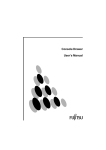
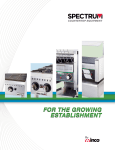
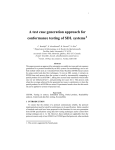
![SERVIS Drawer 17inch [FD-1100AT] User`s Manual](http://vs1.manualzilla.com/store/data/005815433_1-e0ce1fd89f0d0c8bc9b31edbdc395367-150x150.png)

